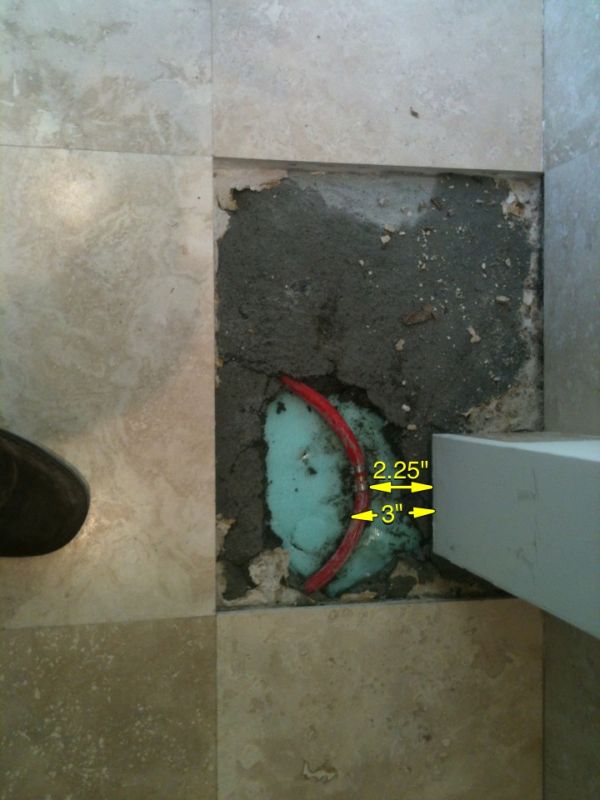Drilling Into Radiant Floor Heating Tubes
Oops! A woodworker installing a door learns his lesson when he drills into a hydronic heating tube in the concrete slab floor. May 15, 2014
Question
Yes, I did it. Today. Installing a restaurant kitchen type door (flips both ways - think it's called a bypass, whatever). Anyhow, I did recall radiant heat tubes are usually set at 6" in from walls. However, some of the interior walls must have been built after the radiant heat tubes were run. As I drilled my 3 hole into the floor… pppfffttt... water like from a drinking fountain on meth. It subsided quickly, I cleaned it up in a panic while trying to contact the GC, then plumber. Finally drained system and unplugged boiler (guy who installed system walked me through it on phone). Now comes my thought... Is this my fault, as some walls were running over the tubes, so negating the 6" from wall rule? Somehow I think not. I think this time it was my mistake.
Forum Responses
(Architectural Woodworking Forum)
From contributor M:
I think this depends on many factors. What was the GC's and owner's reaction? Try to not focus on the blame, just on fixing the problem. If others insist on you fixing it, you probably should. It should not take more than a day to fix. Open the slab to expose pipe, fix it, pour a quick setting mix, and trowel it out.
From contributor Q:
This is what plans are for. Did this job have one, or was it thrown together in typical GC fashion? How did the framers avoid the pex? Luck? How much money did the GC save by convincing the hydronic guy to disregard the floor plan (or by going with the guy who bid it this way)? Or, who changed the wall location? Is the job otherwise running smoothly, or are disasters common fare?
Responsibility lies somewhere in doing a reasonable job to avoid mistakes. What's reasonable for this job? I wouldn't be too eager to reward the GC for slapping a job together, if that's the case. If it's everyone's job to design the project, then you can bet no one's doing it. Is that situation your responsibility? You did what you had to do to minimize the damage. Let it end there, and start talking about needing clearance to install the door.
From contributor S:
If you knew there was radiant heat and drilled the hole before confirming location with either the installer or the GC, you could be on the hook for the repair. Relying on "rules of installation" for anything is meaningless these days; in my experience, few workers know of or care about them, many supervisors just don't bother to make notes or take pics. I have to deal with this constantly on a few properties I work on. Always a (sometimes dangerous!) surprise buried somewhere.
Like mentioned above, damage is minimal, try not to sweat it. These things happen; especially when the GC doesn't stay on top of the job.
From contributor M:
Pretty simple tool that helps us, infared thermometer. Sells for 30 dollars. Crank up the heat and read the floor. Works on electric or hydronic. You only need to make that mistake once.
From the original questioner:
I split the bill with the homeowner. He told me that the wall was an afterthought (after radiant heat was installed). All worked out. Well, I still need to re-install the door tomorrow, ha ha. I had the tile guy put a piece of metal over the pipe just in case...

Click here for higher quality, full size image
From contributor D:
Simple solution to drill into a floor with radiant heat. Use a laser surface heat indicator after you turn on the radiant heat. Run the beam across the floor and monitor the low to high heat readout. It will show you exactly where the radiant heat runs are within the slab. Used this many times and always works.
From the original questioner:
There's a HDE temperature gun infrared thermometer with laser sight at Amazon. Is this what you mean? What if the heat is already on? Still work?
From contributor J:
That is an inexpensive one which should be just fine for your needs. If the floor/room is at temperature, the floor will be evenly heated. Just turn the temperature up so the circulating pumps are running with hotter water. Beware smart systems will adjust water temperature based on how cold it is. The setting has to be raised to increase the water temperature significantly, then wait 20 minutes. You should be able to see a temperature difference between the lines and the surrounding area. If it's summer then the floor will be ambient temperature or nearly that and you can turn on the heat. Again, make sure that the boiler isn't locked out because it's too warm outside. Talk to the original (or any reputable) heating contractor and they can walk you through this.